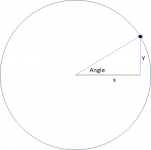Don't say I didn't warn you.
The setup:
View attachment 8196409 D = distance to the target
y = the movement across the paper
x = "roughly the distance to the target" (we're gonna get to that shortly)
Why in the hell did I draw a circle? By drawing the circle and setting up the problem, x and y are related to D via the trig functions.
y = D sin Angle
x = D cos angle
However, lets take a known Angle and distance. Your distance is 100 yards or 3600 inches (D). If I pick the angle to be 1 Minute of Angle, We actually know y, its the infamous 1 inch! (actually 1.047, but lets make the math easy).
Here's the fun part. x and D are essentially the same length. If D = 3600 then x = 3600 Cos (1/60)
Now while you kids were out partying, maths people learned that the cos of a small angle is 1. the actual value is 0.99999995. So x is exactly 3599.9998.
Hopefully we can agree that this is "approximately" 100 yards.
So to move the bullet 1 inch at 100 yards, you need to distrub the end of the barrel by 1MOA.
View attachment 8196415 So the question becomes how far is the red distance when the fat black lines are your barrel. When you aim the gun, you are moving the barrel. We know the angular movement, so what is the physical movement.
So if you barrel length is 20 inches, the red part is just 20 sin (1/60) (in inches). That value happens to be .0003
So you need to disturb end the barrel 0.006 inches
Another 'trick" is that when the angle is small sin x = x, BUT the angle has to be in radians (note NOT MILLIRADIANS!)
But I'm not here to math flex--how do you go from degrees to radians? multiply by pi/180. But pi is roughly 3. 3/180 = 60
so sin x = x = 1/(60*60) first 60 is MOA 2nd 60 is from conversion to radians.
so x is 1/3600 or a circle. But we know our circle radius, so that arc length is the angle times the distance.
Distance is 3600 inches. sin x is roughly 1/3600
3600/3600 = 1
Shouldna skipped math class.
PS if you want to figure our how much you need to move the stock, it works the same way. Take your LOP (roughly) and form another triangle. if your LOP is 14" and you need 1MOA of movement:
14 * 0.0003 = 0.004 Inches. So a bump of 4 thou at the butstock moves your bullet 1 inch at 100 yards.
This works in all directions, left/right/up/down.
If you want 1/2 an inch. divide by 2.
Non trig way:
I want the movement to be 1 inch.
Keep the ratios the same
View attachment 8196425 barrel/3600 = x
x = .0003 if the barrel is 20 inches.

